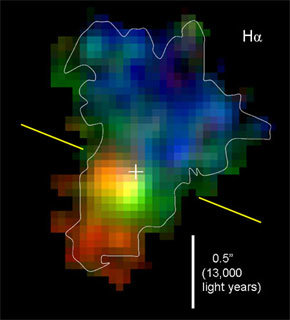Resolved studies of high redshift galaxies:
Witnessing the growth of galaxies at z ~ 1 – 3

Spatially- and spectrally-resolved information of the rest-frame optical
line and continuum emission is proving very powerful in exploring the
baryonic mass assembly and star formation of distant galaxies.
With our major SINS and zC-SINF surveys of near-IR imaging
spectroscopy with SINFONI, coupled with Hubble Space Telescope imaging and
multi-line spectroscopic observations with LUCI, we are investigating
in detail the resolved gas kinematics, stellar populations and structure,
and physical properties of young star-forming galaxies a few billion years
after the Big Bang.
These surveys are revealing the importance of internal galaxy dynamics in
growing early disks and bulges, and the nature and energetics of feedback
— pinning down for the first time details of physical processes
driving and regulating early galaxy evolution in the emerging
"equilibrium growth model."
KMOS3D, our new multi-year survey with
the KMOS instrument, will take the next step towards a comprehensive and unbiased
view of the resolved properties of galaxies at the heyday of massive galaxy formation.
SINS, and its recent extension zC-SINF,
takes advantage of the unique opportunities afforded by
SINFONI at
ESO's Very Large Telescope on Cerro Paranal,
Chile, a near-infrared integral field spectrometer combined with an adaptive optics
system that delivers sharp images simultaneously with high resolution spectral
information.
The multiplexing capabilities of the
LUCI near-IR multi-slit
spectrograph and imager at the
Large Binocular Telescope on
Mount Graham, near Tucson, Arizona, make surveys of multiple emission lines of
large samples up to 20 times more efficient than classical single-object long-slit
instruments.
The recently commissioned
KMOS instrument at the Very Large
Telescope features the unprecedented combination of integral field spectroscopic
and multiplexing, with its 24 integral field units patrolling a wide
field of 7 arcmin in diameter, opening up an entirely new dimension in
detailed spatially- and spectally-resolved studies of distant galaxies.
We participate in:
- IMPRS: the International Max-Planck Research School on Astrophysics
We were also part of: